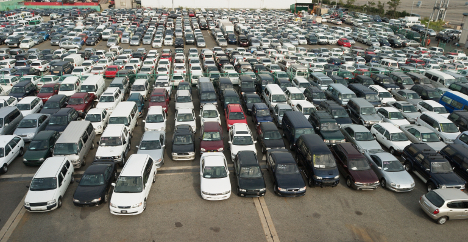Manheim Index finishes Q1 with 3 straight declines

Cox Automotive chief economist Tom Webb looked to quell any negative reactions because wholesale used-vehicle prices declined again in March, marking the third consecutive drop.
The streak left the Manheim Used Vehicle Value Index — a measure of wholesale prices adjusted for mix, mileage and season — at a reading of 122.5 in March, representing a decrease of 1.6 percent from a year ago.
In his commentary posted on Manheim Consulting’s website, Webb said, “Although wholesale prices have fallen every month in 2016, this should not be looked at with alarm. After all, it has long been anticipated that pricing would ease this year.
“Additionally, evolving industry patterns and practices may be muting what used to be a very strong spring bounce in pricing,” he continued. “Remember, wholesale prices did increase somewhat this year before the seasonal adjustment, and the large seasonal adjustment factor is based on past history, which may be less relevant in today’s market.
“Nevertheless, fundamentals do suggest that the current trend will prove longer lasting than the several short cycles that we have already experienced since the May 2011 peak in the Manheim Index,” Webb went on to say.
Manheim reported that Q1 wholesale pricing trends for vehicle segments included:
• Compact car prices were down 9.1 percent in March over the same period last year and continued to underperform the overall market due to extremely competitive pricing of new vehicles and more consumers shifting to small crossovers.
• Midsize cars, typically one of the weaker segments, showed a somewhat modest decrease of 1.7 percent compared with other car classes over the same period last year.
• Pickups and vans showed mixed results as pickups represented the only uptick of all major market classes with a 7.4 percent increase while vans were down 2.4 percent. The increase in pickup pricing can be partially attributed to lower gas prices.
• Luxury car wholesale pricing performed poorly this quarter after stabilizing at the end of 2015 and was down 3.4 percent compared with last March.
• SUVs and CUVs decreased 2.0 percent compared with last March despite the continued increase of vehicle miles of travel thanks to lower gas prices and favorable lending.
“While fundamentals suggest the current pricing trend will last longer than the earlier downturns in pricing in this cycle, the year as a whole is setting up well and we may be able to avoid extreme volatility in wholesale pricing,” Webb said in a separate press release Manheim sent to the media.
For rental risk units, Manheim noticed auction sales rose in March as higher new unit sales into rental allowed the retiring of older units in the fleet. The average auction price — adjusted for broad shifts in mix and mileage — rose 1.0 percent from February, but was down 7.3 percent from a year ago.
Manheim also mentioned vehicles in the $7,000 to $10,000 price range continued to face the most competitive pricing pressure in the first quarter while vehicles valued above $15,000 proved better. The percentage growth in auction volume was slanted towards units above $25,000.
In his commentary, Webb described it as “a twist on Say’s law — units forced back into the wholesale market must then be retailed.” He indicated that preliminary numbers suggest that dealers had another strong used vehicle sales month in March.
According to the National Automobile Dealers Association, both franchised and independent dealers had double-digit gains in used-vehicle sales for the first two months of 2016. Additionally, with an increase of 215,000 jobs in March, total U.S. employment has risen by 13.9 million jobs over the past six years.
Webb insisted the stability in the labor market — measured by initial jobless claims or job openings per job seeker — provides the foundation for low risk-adjusted delinquency rates and, thus, good credit availability.
“As a testament to this, overall CPO sales were up 5.1 percent in the first quarter with March coming in especially strong with a 9.6 percent increase,” he said.
On the new-car side, Webb noted March’s new vehicle selling pace (16.5 million, and well below expectations) is hard to analyze given another two-day “selling day” adjustment, which acknowledged as “a quaint notion, at best.”
For the quarter, Webb recapped that the new-vehicle SAAR came in at 17.1 million.
“The question is whether manufacturers will be content with a full-year sales tally similar to last year or they will push for a more aggressive target,” Webb said. “We’re optimistic they will remain disciplined given that it is they who, through their captive finance arms, hold the residual risk on some 10 million off-lease units outstanding.”


